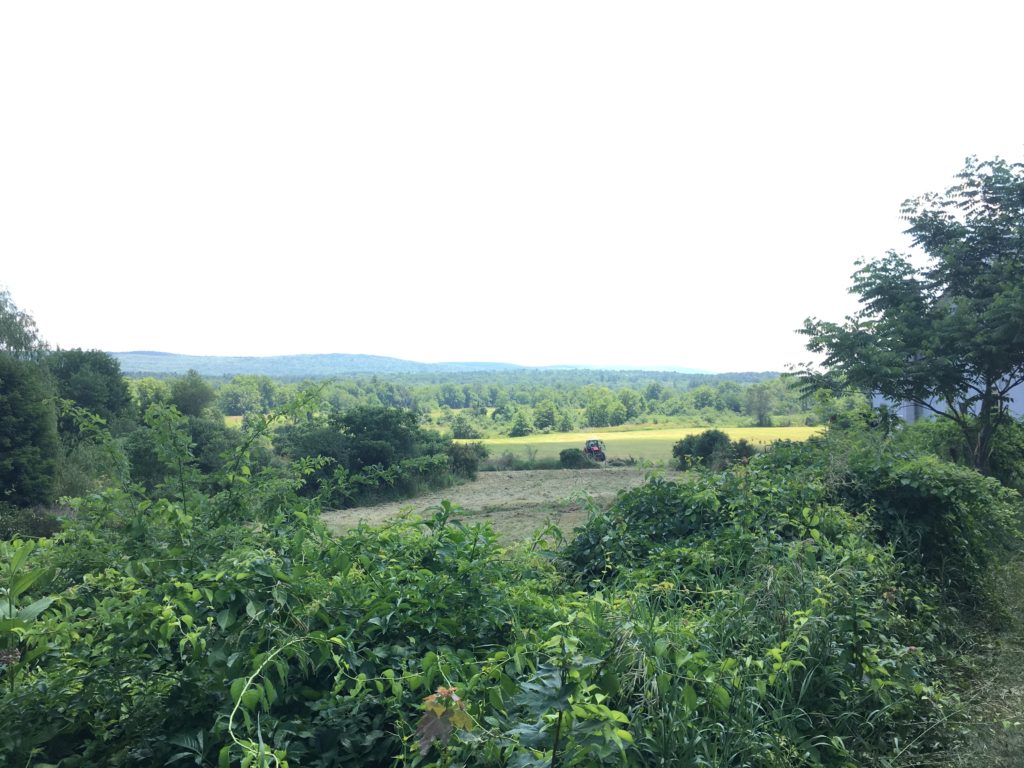
Midground: Removing overgrown, broken fencing for easier, safer access to hay fields.
(Photo © 2019 Karl Zimmerman; all rights reserved. Used by permission.)
Verge is an old word, usually defined as a transitional border between two larger, contrasting areas or as a threat to cross over a line. In our greater New England biome, verges provide important wildlife habitat and brakes on soil erosion. Farming has always involved reckoning with the benefits and challenges of verges.
The Plants
Native and non-native invasive species have overgrown the fences at Thistlebloom. That’s provided abundant wildlife habitat, but impeded necessary access to managing the land. The lush green of uninvited covering is undeniably beautiful. It can attract birds, beneficial insects and small mammals. But it ruins fencing that keeps people and farm animals safe.
At Thistlebloom, invasive plants aren’t just choking out most of the native species that would once have flourished there. They’ve begun to swallow up the barns and silos. Even the farmhouse, already in need of repair, is on the verge of succumbing to the moisture and darkness that wreck buildings. Little forests of volunteer Norway maples are thriving just inches from the foundation. Those baby trees are easy to pull when they’re an inch high, but at five or six feet, their roots are taking hold of the foundation.
The Critters
It’s sad to see the squirrels and barn swallows mourning the loss of habitat and food so close to where they’ve long nested. Both those critters present their own problems, but they’re fun to watch and swallows wolf down mosquitoes with gusto! But if we don’t remove the most severe overgrowth, the buildings will collapse and the farm will die. And opening up a few of the voluntary verges that hid broken, rusty wire in thorns and poison ivy will help those who work on the land to stay safe.
Sooner than I think, though, wilder areas will grow again, close enough for the swallows to find food easily and still nest there. But this time they’ll be far enough from the buildings to let them breathe and function as they were meant to. The squirrels will find their way to the trees a few dozen yards away.
Or maybe they’ll take up residence in the the milk barn’s rafters where they can pelt us with butternut shells.
hello catherine…congratulations on your purchase of thistlebloom farm…my name is dale, and I am currently working at simple gifts farm in Amherst…your name was given to me…in response to a recent facebook post of mine regarding a regenerative permaculture homestead. I moved to the pioneer valley 4 years ago shortly after discovering the term permaculture and taking a permaculture design certification course with sowing solutions…Prior to that, concerns regarding climate change had me on a quest for land and an understanding about how soil works and growing food. My goal at the time was to start a small sustainable homestead capable of supporting myself and adult children along with their families in a worst case climate change scenario (without alarming my children). This has evolved into a desire to establish a network of sustainable regenerative homesteads capable of supporting themselves and local community in the best of times…and taking in displaced populations along with training them in order to expand the network in a worse case scenario. I would love to meet with you and your husband to discuss your dream for thistlebloom…the pioneer valley is a mecca for permaculture designs and at the very least I would like to put in in touch with some of the amazing design resources in this area…for the benefit of all….dale
Hi Dale,
Thank you for getting in touch! Please feel free to email me at catherine@thistlebloomfarm.com so we can talk more about this.
Best,
Catherine